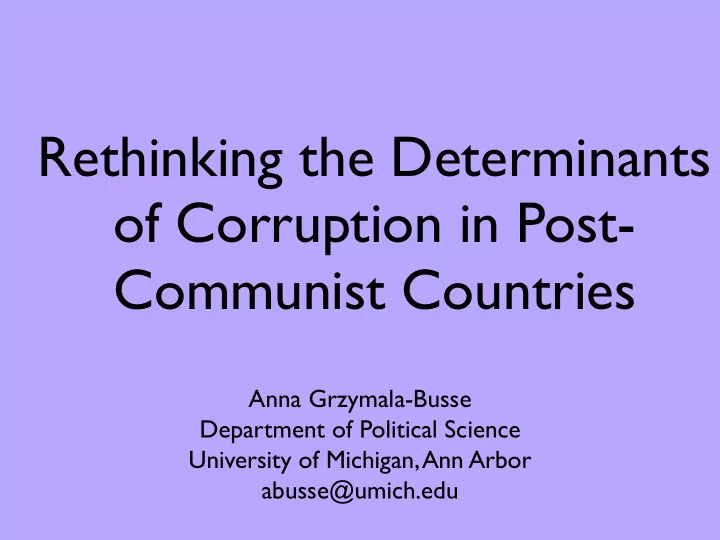

Rethinking the Determinants of Corruption in Post- Communist Countries Anna Grzymala-Busse Department of Political Science University of Michigan, Ann Arbor abusse@umich.edu
Corruption • Use of public goods for private benefit • Elite vs. “petty,” political vs. bureaucratic, etc. • Implications for good governance: TI, WB, IFI interest
Post-communist cases as laboratory: • considerable variation in corruption: Slovenia and Estonia (France, Spain, Japan) to Tajikistan, Turkmenistan, Azerbaijan (Nigeria, Bangladesh, Haiti) • similar baseline: communist legacy
Variation: Corruption score: FH and TI Slovenia 2.55 Estonia 3.35 Poland 4.50 Hungary 4.75 Czech Republic 4.90 Lithuania 4.95 Latvia 5.10 Slovakia 5.25 Croatia 6.10 Bulgaria 6.15 Romania 6.50 Macedonia 6.80 Moldova 6.80 Belarus 7.00 Russia 7.25 Albania 7.40 Armenia 7.40 Georgia 7.40 Ukraine 7.80 Kyrgyzstan 7.95 Uzbekistan 8.00 Kazakhstan 8.05 Turkmen. 8.10 Tajikistan 8.15 Serbia 8.25 Azerbaijan 8.40
Potential Explanations: • cultural determinants: Protestant, colonial legacies, family and kinship structures.
Potential Explanations: • cultural determinants: Protestant, colonial legacies, family and kinship structures. • economic development: GDP per capita, natural resources and their curses.
Potential Explanations: • cultural determinants: Protestant, colonial legacies, family and kinship structures. • economic development: GDP per capita, natural resources and their curses. • electoral institutions (personalized vs. party, presidential vs. parliamentary)
Potential Explanations: • cultural determinants: Protestant, colonial legacies, family and kinship structures. • economic development: GDP per capita, natural resources and their curses. • electoral institutions (personalized vs. party, presidential vs. parliamentary) • political and economic competition: monitoring and efficiency.
Competition key • Cultural and economic explanations: underspecify mechanisms. • Existing institutions, international actors, media, civil society, etc all weak constraints. • State and state actors, rather than firms or economic actors. • Elite competition as critical to state-building and rent-seeking.
But... • If elite competition key, measurement critical • Accepted proxies for competition tell us little about political party motivations or behavior • no mechanisms: what do parties do? • no empirical correlation
Measuring competition • Fragmentation, ENPP , turnover, openness, polarization, volatility, average excluded vote (Frye 2002, Orenstein 2001, Hellman 1998, Przeworski 1999, Grzymala-Busse 2003) • General measures of democracy (Persson and Tabbellini 2000, Ades and diT ella 1997, Treisman 2000, Montinolla and Jackman 2002, Hellman and Kauffman 2001) • Power-sharing institutions (Weingast 1995, Geddes and Neto 1992)
These measures problematic: • underspecified: what matters? • few mechanisms • often rely on exogenous and stable institutions
Better measure of competition • ROBUSTNESS • clear: alternative to both voters and other actors. • plausible: not excluded a priori as government. • critical: investigations and questions.
Indicators • clear: authoritarian exit (new democracies) and/ or voter differentiation • plausible: % seats held by parties excluded from coalitions a priori • critical: # of questions/ MP/ year and # of parliamentary investigations launched/ year
Hypothesis: • Robust competition constrains corruption
Boundary conditions: • Parliaments exist • New and would-be democracies (authoritarian exit) • Political parties
Bivariate correlations between corruption index and competition proxies, all post-communist cases: robust fragment gov't openness of average ENPP competition polarization volatility opposition -ation continuity excluded vote corrupt Pearson -.854** -.226 -.120 .476* .443 -.091 -.077 .540* index Correlation Sig. (2- .000 .313 .596 .025 .050 .688 .740 .025 tailed) n 22 22 22 22 20 22 21 17 Bivariate correlations between corruption and competition proxies, democracies only average robust fragmen gov't openness of ENPP competition polarization volatility excluded opposition tation continuity vote Pearson corrupt Correlatio -.865** -.403 -.423 .183 .358 .118 .117 .531* index n Sig. (2- .000 .122 .102 .497 .173 .664 .665 .034 tailed) n 16 16 16 16 16 16 16 16 ** Correlation is significant at the 0.01 level (2-tailed). * Correlation is significant at the 0.05 level (2-tailed).
Competing hypotheses • Cultural hypothesis: % Protestant population (colonial legacies not tested) • Economic development: natural resource dependence (% of exports), per capita GDP 1990 and 2000 (logged and in PPP) • Institutions: % seats elected via party lists
Unweighted OLS regressions: corruption index as dependent variable 1 2: 3: 4 Robust -.549** -.434** -.198* -.300* Opposition (.147) (.130) (.111) (.156) -.744 -.587 -.342 -.547 Fragmentation -4.489 -4.71* (2.87) (2.35) -.233 -.245 Excluded vote .026 .025 (.13) (.029) .130 .127 Continuity in .134 .799 office (1.64) (1.37) .014 .083 Polarization .197 .023 (.026) (.022) .106 .127 Volatility .0024 .009 (.027) (.022) .001 .053 % seats elected -1.688* .019 via party lists (.721) (.861) -.275 .005 1993 fuel / metal .009 .011 exports as % (.011) (.022) total exports .124 -.117 % Protestant -.017 .028* (.012) (.015) -.154 -.326 Log per capita -1.250 GDP/PPP 2000 (.350)** -.520 Log per capita -.830 GDP/PPP 1990 (.761) -.253 Constant 10.99*** 11.02*** 17.40*** 14.96** (2.28) (1.86) (2.59) (5.934) Adjusted R 2 .743 .829 .811 .630 N 25 24 24 24
Caveats: • Perceptions of corruption, rather than objective measures • Elite, rather than bureaucratic, corruption • Small sample size (n=26)
Mechanisms of constraint: • constructing formal guarantees / abolishing discretionary access to state resources • monitoring and sanctions • opposition as alternatives: limits accumulation of resources
Origins of robust competition • Resources and incentives to construct, monitor, sanction • Former authoritarians: exit and adaptation
Further research: • Disaggregating components of robust competition • Investigate impact over time: lags and path dependence?
Extensions: • No parliaments or parties: elite competition still matters (extends time horizons, constrains) • Weak states/ inchoate institutions: informal mechanisms of sanction and monitoring critical • Key question: how to get political actors to act as if they are vested in public good provision
Conclusions: • Focus on elites • Competition critical • Organization, access to state resources, and need to extract • ex-authoritarians as main actors
Recommend
More recommend